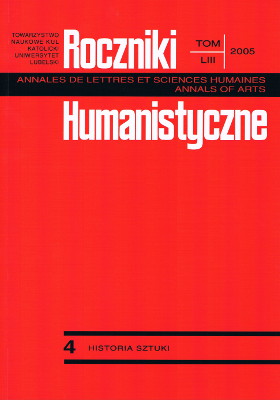Wooden Sculptures of Lions in Polish Medieval Art
Abstract
The subject of the article “Wooden sculptures of lions in Polish medieval art” are lying lions grouped in bigger complexes of sculptures. Twenty-nine of them are assembled in the circle of the Cistercian order - in Cistercian and post-Cistercian churches and monasteries in the whole area of Poland, that is in Koprzywnica, Sulejów, Szczyrzyca, Kraków-Mogiła, and Ląd upon Warta. The remaining twenty-four sculptures of lions are found in parish churches or in other places that are not connected with the Cistercian order in Poland, i.e. in Dobre Miasto, Leżajsk, Borek Wielkopolski and Koźmin Wielkopolski.
The Middle Ages are the time when the lions are believed to have been sculptured, and the researchers usually point to the 13-16th centuries. In some cases (Ląd upon Warta, Borek Wielkopolski, Koźmin Wielkopolski) the lions are dated to a later period, namely to the 17-18th centuries, and they are pointed to as a continuation of the medieval type of the “bearing lion” .
In their form the sculptures are a continuation of the stone and bronze works of European medieval sepulchral art. The functional form of the bodies of the lions that suggests bearing weights, as well as the movable character of the wooden figures lead one to suppose that they were part of the catafalque construction for bearing the coffin during funeral celebrations. Lions with cushions on their backs in the post-Cistercian churches in Sulejów and Koprzywnica could be used as seats for holding a vigil over the dead, which was the usual practice during funeral services.
In the context of sepulchral art the lion expresses the eschatological truth, that is defeating death by Christ and Ressurection. It is a sign of faith and of hope for an eternal life.
References
Adhemar J., Dordor G., Catalogue des tombeaux de la collection Gaignieres a la Bibliotheque Nationale. Dessins d'archeologie du XVII siecle. „Gazette des Beaux – Arts” 1(1974), 2(1976).
Bauch K., Das mittelalterliche Grabbild: figürliche Grabmäler des 11. bis 15. Jahrhunderts in Europa, Berlin 1976.
Białoskórska K., Imago leonis. Drewniane rzeźby lwów z XIII w. z opactw cysterskich w Koprzywnicy i Sulejowie. Funkcja i treści ideowe, W: Cystersi w społeczeństwie Europy Środkowej, red. A. M. Wyrwa, Poznań 2000, s. 581-623.
Bidermann H., Knaurs Lexicon der Symbole, Augsburg 2000.
Champeaux de G., Sterckx D. S., Einführung in die Welt der Symbole, Würzburg 1990.
Chrzanowski T, Kornecki M., Sztuka Śląska Opolskiego. Od średniowiecza do końca w. XIX, Kraków 1974.
Cooper J. C., Zwierzęta symboliczne i mityczne, Poznań 1998.
Cystersi w Szczyrzycu: historia i kultura. Katalog wystawy w galerii „Dawna Synagoga”, red. R. Ślusarek, Nowy Sącz 2000.
Debidour H. V., Le bestiaire sculpte du moyen age en France, Strasbury 1961.
Dolberg L., Sterben und Begräbnis eines Cisterciesers, W: Studien und Mittheilungen aus dem Benedictiner und dem Cistercienser – Orden, t. 19, 1898, s. 256-264, 433-440.
Domasłowski J., Kościół i klasztor w Lądzie, Warszawa 1981.
Forstner D. OSB, Świat symboliki chrześcijańskiej, Warszawa 1990.
Heinz-Mohr G., Lexicon der Symbole. Bilder und Zeichen der christlichen Kunst, München 1971.
KZSP (Katalog Zabytków Sztuki w Polsce), t. III. Woj. kieleckie, z. 3. Pow. opoczyński, red. J. Łoziński, B. Wolff, Warszawa 1958.
KZSP, T. III. Woj. kieleckie. Z. 11. Pow. sandomierski, red. J. Łoziński, B. Wolff, Warszawa 1962.
KZSP. T. I. Woj. krakowskie, z. 7. Pow. limanowski, red. J. Dudkiewicz, Warszawa 1951.
KZSP. T. V. Woj. poznańskie, z. 4. Pow. gostyński, red. T. Ruszczyńska, A. Sławska, Warszawa 1961.
KZSP. T. V. Woj. poznańskie, z. 11. Pow. krotoszyński, red. T. Ruszczyńska, A. Sławska, Warszawa 1973.
Kębłowski J., Nagrobki gotyckie na Śląsku, Poznań 1969.
Kopaliński W., Słownik symboli, Warszawa 1990.
Lurker M., Słownik obrazów i symboli biblijnych, Poznań 1989.
Łuszczkiewicz W., Opactwo Sulejowskie – zabytek architektury XIII w. SKHSP („Sprawozdania Komisji do Badania Historii Sztuki w Polsce”) 1(1879), s. 3-24.
Łuszczkiewicz W., Kościół i reszty klasztoru cysterskiego w Koprzywnicy. Przyczynek do dziejów romańszczyzny w Polsce, SKHSP 3(1888), s. 38-63.
Rogoziński M. ks., Zabytki polskiego średniowiecznego snycerstwa, Poznań 1937.
Rzempołuch A., Zespół kolegiacki w Dobrym Mieście, Olsztyn 1989.
Schmidt H. i M., Die vergessene Bildersprache christlicher Kunst. Ein Führer zum Verstandnis der Tier-Engel-und Mariensymbolik, München 1984.
Sokołowski M., Sprawozdania z Posiedzeń Komisyi Historyi Sztuki za czas od 1 stycznia do 31 grudnia 1908 r., SKHSP 9(1915), s. 226.
Sztuka polska przedromańska i romańska do schyłku XIII wieku, red. M. Walicki, Warszawa 1971.
Vanitas. Portret trumienny na tle sarmackich obyczajów pogrzebowych, red. J. Dziubkowa, Poznań 1996.
Copyright (c) 2005 Roczniki Humanistyczne

This work is licensed under a Creative Commons Attribution-NonCommercial-NoDerivatives 4.0 International License.





